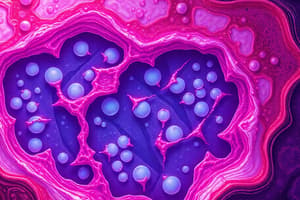Podcast
Questions and Answers
What is a tissue?
What is a tissue?
A collection of similar cells and the extracellular matrix surrounding them that perform a related function.
Which of the following is NOT one of the primary types of tissue?
Which of the following is NOT one of the primary types of tissue?
- Nervous tissue
- Muscle tissue
- Skeletal tissue (correct)
- Epithelial tissue
The study of tissues is called ______.
The study of tissues is called ______.
histology
What is the function of epithelial tissue?
What is the function of epithelial tissue?
Which characteristic applies to epithelial tissue?
Which characteristic applies to epithelial tissue?
Match the types of epithelial tissue to their characteristics:
Match the types of epithelial tissue to their characteristics:
Which type of gland does NOT have ducts?
Which type of gland does NOT have ducts?
Name one function of connective tissue.
Name one function of connective tissue.
Epithelial tissue has a rich supply of blood vessels.
Epithelial tissue has a rich supply of blood vessels.
Flashcards are hidden until you start studying
Study Notes
Overview of Tissues
- Tissues are defined as collections of similar cells and their extracellular matrix, performing related functions.
- Histology is the study of tissues.
Four Primary Types of Tissue
- Epithelial tissue
- Connective tissue
- Muscle tissue
- Nervous tissue
Epithelial Tissue
- Covers body surfaces and cavities; characterized by tightly packed cells with minimal extracellular material.
- Avascular; relies on diffusion for nutrient uptake.
- Supported by a basement membrane.
Functions of Epithelial Tissue
- Protection: Outer skin layer, mucosa lining.
- Barrier Formation: Prevents substance passage (e.g., skin).
- Substance Passage: Facilitates gas exchange in lungs.
- Secretion: Produces mucus in glands.
- Absorption: Nutrient uptake in the intestine.
Classification of Epithelial Tissue
- By Shape:
- Squamous (flat and thin)
- Cuboidal (cube-shaped)
- Columnar (tall and thin)
- By Arrangement:
- Simple (single layer)
- Stratified (multiple layers)
- Pseudostratified (appears layered, but is not)
- Transitional (can stretch)
Stratified Epithelium Types
- Stratified squamous
- Stratified cuboidal
- Stratified columnar
- Transitional epithelium
Functions of Epithelial Tissue by Type
- Mucous Membrane: Secretes mucus, enzymes, absorbs nutrients, protects.
- Glandular Epithelium: Forms glands for secretion.
- Endothelium: Lines blood and lymphatic vessels.
- Mesothelium: Lines body cavities without external openings.
Epithelial Tissue Glands
- Glands are structures secreting substances; classified as endocrine or exocrine.
- Endocrine Glands: Ductless, secrete hormones directly into blood.
- Exocrine Glands: Possess ducts, secrete onto surfaces or into cavities (e.g., sweat glands).
Structure of Exocrine Glands
- Simple: One duct.
- Compound: Branching ducts.
- Tubule-Ending: Ends in small tubes.
- Acini: Ends in saclike structures.
- Alveoli: Ends in hollow sacs.
Secretion Types of Exocrine Glands
- Merocrine: No cell loss (e.g., sweat glands).
- Apocrine: Part of the cell pinches off (e.g., mammary glands).
- Holocrine: Entire cell is lost in secretion (e.g., sebaceous glands).
Connective Tissue
- Consists of cells separated by an abundant extracellular matrix.
Functions of Connective Tissue
- Enclosing and Separating: Forms compartments within organs.
- Connecting Tissues: Ligaments and tendons connect structures.
- Support and Movement: Bones and cartilage support the body.
- Storage: Fat is stored in adipose tissue; minerals in bones.
- Cushioning and Insulating: Adipose tissue provides cushioning.
- Transporting: Blood transports nutrients and wastes.
- Protecting: Provides structural protection (e.g., bones).
Studying That Suits You
Use AI to generate personalized quizzes and flashcards to suit your learning preferences.




